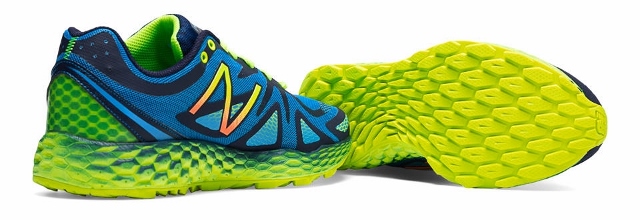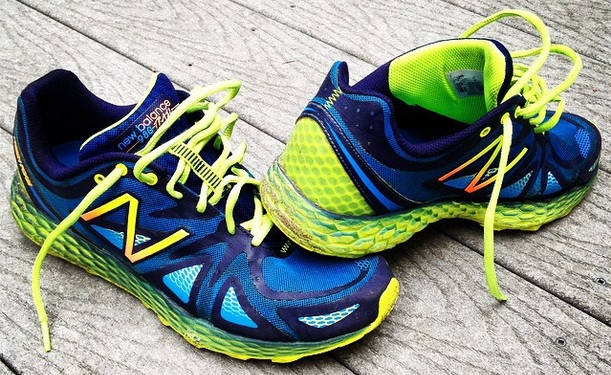Earlier this year I mentioned that New Balance running shoes never resonated with me. But now, I’m loving them.
First it was the New Balance 1400 (I’ve since bought another pair). And now it’s the Fresh Foam 980 Trail.
NB is making waves in the running industry by finally making shoes that runners actually love. They used to have an admittedly lackluster line of running shoes but they’ve turned that all around.
Today I’m impressed by their innovation and commitment to runners. More importantly, they’re passionate about running. A few months ago I met the global PR manager for New Balance who delivered a fascinating presentation on their new line of Fresh Foam shoes. Part of these shoes are inspired by NB’s work in the 3D printing space and the foam material is unlike anything ever made by a shoe manufacturer.
I received a pair of the 980 Trails and was admittedly skeptical. They’re bulkier than my preferred shoe style and the elevated platform worried me; usually this style makes running feel awkward to me or irritates my IT band.
But I was pleasantly surprised at how well the shoes perform on and off-road, including technical trails, steep hills, and boulder scrambling in my recent Garden of the Gods trail running adventure.
They’re not perfect but the 980 Trails are an interesting shoe that I think will work well for many runners.
Fresh Foam 980 Trail: Specs & First Impressions
Let’s take a look at the 980 Trail’s specifications so you know what you’re running in:
- Weight: 10.3 ounces (291 grams)
- Stack height: 24mm (heel), 20mm (forefoot)
- Heel-toe drop: 4mm
- Gusseted tongue and tightly woven mesh upper keeps out debris
Most notably, the sole is constructed of New Balance’s new Fresh Foam material. At first I was doubtful I’d like this shoe because I typically prefer a firm ride (like the AdiZero Boston) but Fresh Foam isn’t super soft. It’s “softish” and is still responsive when running fast.
Note that I had to size up to a 10.5 rather than my standard size 10 running shoe. Other runners have experienced the same sizing issue, so keep that in mind if you decide to try them.
My first few runs in the NB 980 Trails went surprising well. I almost never buy trail running shoes because the outsole can be too rugged and stiff and they feel awkward on smooth surfaces like roads or the track. But the 980’s outsole is just the right blend of traction, smooth running, and grip.
The smooth ride is likely due to the responsive Fresh Foam outsole material, the low heel-toe drop, and also the heel cup being neutral. I’ve talked before about how aggressively flared heels are a red flag for me but the 980 Trail heel is barely flared at all.
Lounging in the Fresh Foam 980 Trail shoes after a workout
Even though they’re technically trail running shoes, I would characterize them as a hybrid – well-suited for both road and trail running. I ran slow on technical single-track and fast on the track and the 980 Trails didn’t disappoint. They can perform in either environment.
I’ve been wearing both the NB 1400 and the 980’s, mostly alternating them every other day. I always wear the 980’s for my longer runs of 11 miles or more but I’ve done short, easy runs in them too.
Before researching these shoes, I wasn’t aware the drop was only 4mm. I’ve run up to 16 miles in them with no problems in my feet or lower legs (thanks to some specific foot exercises!).
What About the New Balance 980 Trails Could Be Improved?
Overall, I love these shoes and I’ll continue to wear them as I explore more trails in Colorado. The responsive cushioning, traction and grip, and the smooth ride make a future purchase of the 980 Trails a no-brainer.
But they’re not perfect. Like all of the shoes I review, there are drawbacks.
The upper seems stiff and while it loosened over time, it makes tying the laces cumbersome. On several occasions I had to stop and retie my shoes because I didn’t get them tight enough the first time around (and I’m not someone who likes really tight shoes in the first place).
There’s also excessive wear beginning to appear on the inner edge of the shoe’s upper. The fabric is becoming frayed from the bending and compression of my foot rolling inward when I pronate. There’s more than 200 miles on them now so this isn’t a big problem, but it’s clear these shoes won’t last for 400+ miles.
Finally, the New Balance 980 Trails are slightly higher than I normally prefer at 20 – 24mm off the ground. Usually this disconnect from the ground makes me feel “clunky” and incredibly unresponsive. But like I’ve mentioned, the 980’s are surprisingly responsive, light, and quick.
Final Thoughts

I think the Fresh Foam 980 Trails are a valuable addition to the New Balance line of running shoes. They offer responsive cushioning, traction with grip for technical trail running, and a ride that also works on the road.
There’s a few situations and types of runners that could benefit from this shoe:
- trail runners who want a cushioned shoe that feels faster than most shoes currently on the market
- ultra runners who want cushioning and protection but “maximalist” shoes like the Hoka One One are too rigid or bulky
- Minimalist runners who occasionally need more protection to help their feet recover
- trail runners who love the Saucony Kinvara but want a more rugged outsole and a firmer ride
As always, it’s important to remember that every runner is unique. Shoes that work for me might cause you to get hurt because of the differences in our biomechanics, form, stride pattern, training history, and susceptibility to injuries.
Learning what fits, feels good, and helps you achieve your potential is a valuable journey that every runner must make. It’s a long process that includes much trial and error but it’s the only way to truly understand the exact type of running shoe that helps you thrive.
It’s helpful to read a lot of shoe reviews but it’s even more important to experiment and run in a lot of brands, styles, and models of shoes.
Ready to experiment with the New Balance Fresh Foam 980 Trail running shoes? Check them out on Amazon, where the prices seem to be the most affordable.
